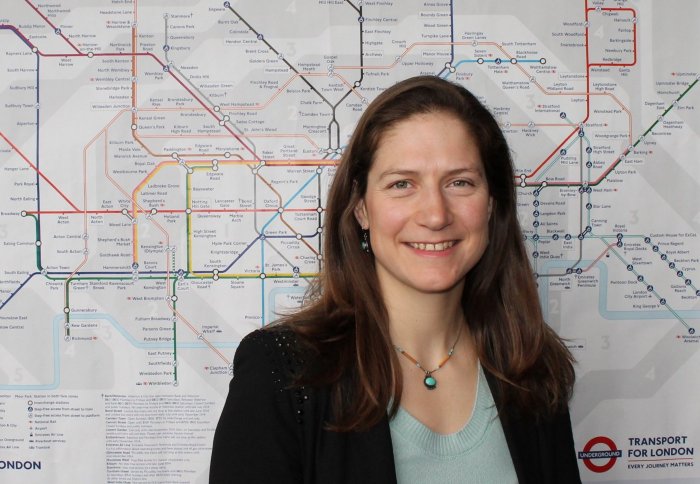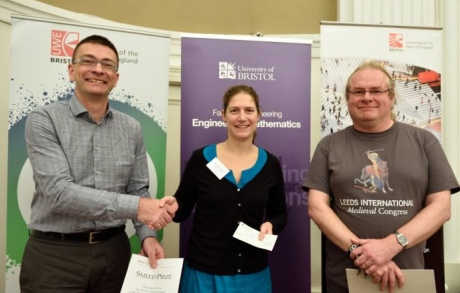
Research Assistant Severine Marechal

Four million people travel on the Tube every day and Imperial researchers are trying to understand how they make decisions and adapt to disruptions.
In February this year, PhD candidate Séverine Maréchal won the coveted SMEED Prize at the 48th Annual University Transport Studies Group (UTSG) Conference in Bristol for her research paper Modelling the Acquisition and Use of Information Sources during Travel Disruption. Here she talks about the implications of her work.
Tell me about your research
I’m investigating the link between how commuters look at travel information, and how this affects their travel decisions during disruption, particularly on their commute in Greater London.
There’s a variety of sources out there from companies bringing travel infomation to the public, but we don’t know how the travellers use these to make decisions. So my work explores how individuals acquire and use specific sources, such as the TfL app or Google Maps, to make informed travel choices.

Severine collects her transport award (credit B Sachania)
It’s a bit unexpected to find this research in the Civil and Environmental Engineering Department, but it really fits here. By determining peoples’ preference parameters, travel behaviour can be modelled in such a way to help predict the future of travel demand. The travel demand allows us to plan for the needs of network, roadways, and public transport capacity. Eventually this leads to the construction and improvement of these infrastructures.
How did you collect your data?
Prior to our work no dataset existed that combined questions regarding travel information use and travel patterns. To gather the ideal dataset, I created an innovative and unique data collection tool.
I started collecting data using focus-groups, from which I wanted to look at the psychological side of how people make travel choices. Depending on the conditions of the disruptions, there will be different types of decision-making.
Travel behaviour can be modelled in such a way to help predict the future of travel demand
– Severine Marechal
Research Assistant
Then I ran a pilot-survey with people from the College. While the results were strongly biased towards academics and students, they were diverse enough to test the modelling framework. Last was the final survey, distributed using a professional panel data company. In total I had around 600 respondents.
For both of these surveys I used a survey programme that allowed me to set up conditions from previous questions. The questionnaire gathered information about demographics, travel information use, and travel patterns.
You recently submitted your paper. What are some of your major findings?
I have identified many factors influencing the type of information source a commuter consults during travel disruptions. The demographics, commute complexity, and level of information-gathering experience play a substantial role in the final travel route. I found that education level and age have a significant effect on the choice of information source. For instance, well-educated commuters are more likely to use Google Maps, but less likely to check it alongside phone apps.
I also touched upon the concept of credibility of information sources. Travellers prefer to check their phone apps because the information may feel personalised, and they can gain more from the high-level functionality a phone app, such as Citymapper, can offer. When individuals perceive sources such as time-boards inaccurate, they are more likely to consult a combination of travel apps in order to increase information credibility.
Additionally, actual travel patterns have a more significant effect on travel behaviour during disruptions than demographics. For example, if a traveller’s usual commute is varied or takes a particularly long time, they display more resilience to disruption and are less likely to become impatient. They will delay consulting travel information sources for longer than if they had a quicker journey time.
Why do you think your research stood out at the UTSG Conference?
The topic is so interesting because of its multidisciplinary nature. It is an intersection of engineering, economics, psychology, and policy. You have to apply knowledge from each of these fields to develop and interpret the protocol, modelling, and results. I’ve been told that the broad range of topics covered, along with the combined appreciation of my paper and presentation, helped confirm my success.
I was also very focused and motivated, which helped as I opened the first session of the conference with my presentation!
What has been one of the highlights of working with your supervisors?
I’m really happy to have had Professor John Polak and Dr Aruna Sivakumar as my supervisors. They have pushed me to develop my skillset and complete my research by teaching me how to be a better researcher. Professor Polak himself won the SMEED Prize in 1983, and this year another of his students, Jianlin Luan, was awarded second prize at the UTSG Conference.
What next for you?
For now I will continue working on submitting parts of my thesis to academic journals. I’m still exploring possibilities to develop my research further. There’s all this new technology that I want to look at, and take into account new ways of looking for travel information. What will come after smartphones? Google glass? Who knows?
Séverine will be presenting her research at the Centre for Transport Studies seminar in the Skempton Building on Wednesday 6th April 16.00-17.00
Article text (excluding photos or graphics) available under an Attribution-NonCommercial-ShareAlike Creative Commons license.
Photos and graphics subject to third party copyright used with permission or © Imperial College London.
Reporter
Melanie Hargreaves
Department of Civil and Environmental Engineering




Leave a comment
Your comment may be published, displaying your name as you provide it, unless you request otherwise. Your contact details will never be published.